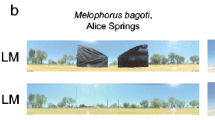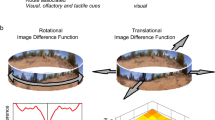Abstract
Ants are excellent navigators, using a combination of innate strategies and learnt information to guide habitual routes. The mechanisms underlying this behaviour are little understood though one avenue of investigation is to explore how innate sensori-motor routines are used to accomplish route navigation. For instance, Australian desert ant foragers are occasionally observed to cease translation and rotate on the spot. Here, we investigate this behaviour using high-speed videography and computational analysis. We find that scanning behaviour is saccadic with pauses separated by fast rotations. Further, we have identified four situations where scanning is typically displayed: (1) by naïve ants on their first departure from the nest; (2) by experienced ants departing from the nest for their first foraging trip of the day; (3) by experienced ants when the familiar visual surround was experimentally modified, in which case frequency and duration of scans were proportional to the degree of modification; (4) when the information from visual cues is at odds with the direction indicated by the ant’s path integration system. Taken together, we see a general relationship between scanning behaviours and periods of uncertainty.






Similar content being viewed by others
References
Andel D, Wehner R (2004) Path integration in desert ants, Cataglyphis: how to make a homing ant run away from home. Proc R Soc B 271(1547):1485–1489
Baddeley B, Graham P, Husbands P, Philippides A (2012) A model of ant route navigation driven by scene familiarity. Plos Comp Biol 8(1):e1002336
Baird E, Byrne MJ, Smolka J, Warrant EJ, Dacke M (2012) The dung beetle dance: an orientation behaviour? PLoS One 7(1):e30211
Cartwright BA, Collett TS (1983) Landmark learning in bees: experiments and models. J Comp Physiol 151(4):521–543
Cheng K, Shettleworth SJ, Huttenlocher J, Rieser JJ (2007) Bayesian integration of spatial information. Psychol Bull 133(4):625–637
Cheng K, Narendra A, Sommer S, Wehner R (2009) Travelling in clutter: navigation in the Central Australian desert ant M. bagoti. Behav Process 80(3):261–268
Collett TS (1995) Making learning easy––the acquisition of visual information during the orientation flights of social wasps. J Comp Physiol A 177(6):737–747
Collett M (2010) How desert ants use a visual landmark for guidance along a habitual route. Proc Natl Acad Sci USA 107(25):11638–11643
Collett M (2012) How navigational guidance systems are combined in a desert ant. Curr Biol 22(10):927–932
Collett M, Collett TS (2000) How do insects use path integration for their navigation? Biol Cyber 83(3):245–259
Collett TS, Land MF (1975) Visual spatial memory in a hoverfly. J Comp Physiol 100:59–84
Collett TS, Dillmann E, Giger A, Wehner R (1992) Visual landmarks and route following in desert ants. J Comp Physiol A 170(4):435–442
Collett TS, Graham P, Harris RA, Hempel-De-Ibarra N (2006) Navigational memories in ants and bees: memory retrieval when selecting and following routes. Adv Stud Behav 36:123–172
Collett TS, Graham P, Harris RA (2007) Novel landmark-guided routes in ants. J Exp Biol 210(12):2025–2032
Durier V, Graham P, Collett TS (2003) Snapshot memories and landmark guidance in wood ants. Curr Biol 13(18):1614–1618
Fourcassie V (1991) Landmark orientation in natural situations in the Red Wood Ant Formica-Lugubris-Zett (Hymenoptera, Formicidae). Ethol Ecol Evol 3(2):89–99
Fukushi T (2001) Homing in wood ants, Formica japonica: use of the skyline panorama. J Exp Biol 204(12):2063–2072
Graham P, Cheng K (2009a) Ants use the panoramic skyline as a visual cue during navigation. Curr Biol 19(20):R935–R937
Graham P, Cheng K (2009b) Which portion of the natural panorama is used for view-based navigation in the Australian desert ant? J Comp Physiol A 195(7):681–689
Graham P, Collett TS (2002) View-based navigation in insects: how wood ants (Formica rufa L.) look at and are guided by extended landmarks. J Exp Biol 205(16):2499–2509
Graham P, Collett TS (2006) Bi-directional route learning in wood ants. J Exp Biol 209(18):3677–3684
Graham P, Durier V, Collett TS (2004) The binding and recall of snapshot memories in wood ants (Formica rufa L.). J Exp Biol 207(3):393–398
Harris RA, Graham P, Collett TS (2007) Visual cues for the retrieval of landmark memories by navigating wood ants. Curr Biol 17(2):93–102
Judd SPD, Collett TS (1998) Multiple stored views and landmark guidance in ants. Nature 392(6677):710–714
Junger W (1991) Waterstriders (Gerris paludum F) compensate for drift with a discontinuously working visual position servo. J Comp Physiol A 169(5):633–639
Kohler M, Wehner R (2005) Idiosyncratic route-based memories in desert ants, M. bagoti: how do they interact with path-integration vectors? Neurobiol Learn Mem 83(1):1–12
Lent DD, Graham P, Collett TS (2009) A motor component to the memories of habitual foraging routes in wood ants. Curr Biol 19(2):115–121
Lent DD, Graham P, Collett TS (2010) Image-matching during ant navigation occurs through saccade-like body turns controlled by learned visual features. Proc Natl Acad Sci USA 107(37):16348–16353
Lent DD, Graham P, Collett TS (2013) Visual scene perception in navigating wood ants. Curr Biol 23(8):684–690
Mangan M, Webb B (2012) Spontaneous formation of multiple routes in individual desert ants (Cataglyphis velox). Behav Ecol 23(5):944–954
Möller R (2012) A model of ant navigation based on visual prediction. J Theor Biol 305:118–130
Müller M, Wehner R (2010) Path integration provides a scaffold for landmark learning in desert ants. Curr Biol 20(15):1368–1371
Narendra A (2007) Homing strategies of the Australian desert ant M. bagoti. II. Interaction of the path integrator with visual cue information. J Exp Biol 210(12):2212
Narendra A, Si A, Sulikowski D, Cheng K (2007) Learning, retention and coding of nest-associated visual cues by the Australian desert ant, M. bagoti. Behav Ecol Sociobiol 61(10):1543–1553
Narendra A, Cheng K, Sulikowski D, Wehner R (2008) Search strategies of ants in landmark-rich habitats. J Comp Physiol A 194(11):929–938
Narendra A, Gourmaud S, Zeil J (2013) Mapping the navigational knowledge of individually foraging ants, Myrmecia croslandi. Proc R Soc B 280:20130683
Nicholson DJ, Judd SPD, Cartwright BA, Collett TS (1999) Learning walks and landmark guidance in wood ants (F. rufa). J Exp Biol 202(13):1831–1838
Philippides A, Baddeley B, Cheng K, Graham P (2011) How might ants use panoramic views for route navigation? J Exp Biol 214(3):445–451
Reid SF, Narendra A, Hemmi JM, Zeil J (2011) Polarised skylight and the landmark panorama provide night-active bull ants with compass information during route following. J Exp Biol 214(3):363–370
Schultheiss P, Cheng K (2011) Finding the nest: inbound searching behaviour in the Australian desert ant, M. bagoti. Anim Behav 81(5):1031–1038
Schultheiss P, Wystrach A, Legge ELG, Cheng K (2013) Information content of visual scenes influences systematic search of desert ants. J Exp Biol 216(4):742–749
Schwarz S, Narendra A, Zeil J (2011) The properties of the visual system in the Australian desert ant M. bagoti. Arthropod Struct Dev 40(2):128–134
Tarsitano MS, Andrew R (1999) Scanning and route selection in the jumping spider Portia labiata. Anim Behav 58:255–265
Wehner R (2003) Desert ant navigation: how miniature brains solve complex tasks. J Comp Physiol A 189(8):579–588
Wehner R (2009) The architecture of the desert ant’s navigational toolkit (Hymenoptera: Formicidae). Myrmecol News 12:85–96
Wehner R, Räber F (1979) Visual Spatial memory in desert ants, Cataglyphis bicolor. Experientia 35:1569–1571
Wehner R, Srinivasan MV (1981) Searching behavior of desert ants, genus Cataglyphis (Formicidae, Hymenoptera). J Comp Physiol 142(3):315–338
Wehner R, Fukushi T, Wehner S (1992) Rotatory components of movement in high speed desert ants, Cataglyphis bombycina. In: Paper presented at the 20th Göttingen Neurobiology Conference, Göttingen
Wehner R, Michel B, Antonsen P (1996) Visual navigation in insects: coupling of egocentric and geocentric information. J Exp Biol 199:129–140
Wei CA, Rafalko SL, Dyer FC (2002) Deciding to learn: modulation of learning flights in honeybees, Apis mellifera. J Comp Physiol A 188(9):725–737
Wystrach A, Beugnon G, Cheng K (2011a) Landmarks or panoramas: what do navigating ants attend to for guidance? Front Zool 8:21
Wystrach A, Schwarz S, Schultheiss P, Beugnon G, Cheng K (2011b) Views, landmarks, and routes: how do desert ants negotiate an obstacle course? J Comp Physiol A 197(2):167–179
Wystrach A, Beugnon G, Cheng K (2012) Ants might use different view-matching strategies on and off the route. J Exp Biol 215(1):44–55
Wystrach A, Mangan M, Philippides A, Graham P (2013) Snapshots in ants? New interpretations of paradigmatic experiments. J Exp Biol 216(10):1766–1770
Zeil J (1993) Orientation flights of solitary wasps (Cerceris, Sphecidae, Hymenoptera) 2: similarities between orientation and return flights and the use of motion parallax. J Comp Physiol A 172(2):207–222
Zeil J (2012) Visual homing: an insect perspective. Curr Opin Neurobiol 22(2):285–293
Zeil J, Hofmann MI, Chahl JS (2003) The catchment areas of panoramic snapshots in outdoor scenes. J Opt Soc Am A 20:450–469
Zeil J, Narendra A, Stürzl W (2014) Looking and homing: how displaced ants decide where to go. Phil Trans R Soc 369(1636):20130034
Acknowledgments
The experiments detailed here comply with the ethical standards of the countries where they were undertaken and analysed.
Author information
Authors and Affiliations
Corresponding author
Rights and permissions
About this article
Cite this article
Wystrach, A., Philippides, A., Aurejac, A. et al. Visual scanning behaviours and their role in the navigation of the Australian desert ant Melophorus bagoti . J Comp Physiol A 200, 615–626 (2014). https://doi.org/10.1007/s00359-014-0900-8
Received:
Revised:
Accepted:
Published:
Issue Date:
DOI: https://doi.org/10.1007/s00359-014-0900-8




